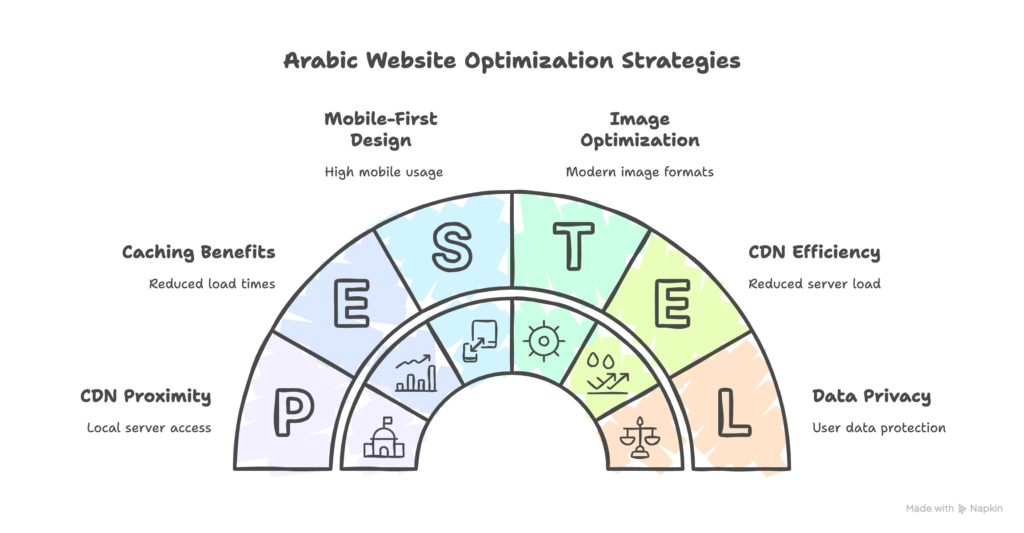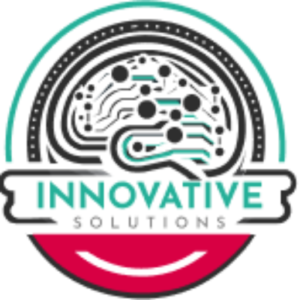In today’s hyper-competitive GCC market, a slow website can quietly bleed revenue. Bahrain and Saudi Arabia boast near-universal internet access (99% penetration[1][2]) and mobile dominates online activity. Saudi Arabia alone had 48.1 million mobile subscriptions in 2025 (140% of its population)[2], and Bahrain 2.52 million (155% of its population)[3]. These savvy consumers expect instant results. In fact, 47% of users expect pages to load in 2 seconds or less[4]. Yet a recent audit found 82% of Saudi business sites took over 5 seconds to load[5]. The result? Frustrated visitors and missed sales. Research shows that even a 2-second delay can double bounce rates[6] and cut conversions in half[4].
This matters especially for Arabic-language sites. Complex Arabic fonts, right-to-left layouts, and heavy content can slow pages if not optimized. But the upside is huge: fast, mobile-first websites keep Bahraini and Saudi visitors engaged, boost conversions, and even improve Google rankings (page speed is now a confirmed SEO factor[7][8]). Below, we explore why performance optimization is critical in the GCC, what it means for user experience and SEO, and practical tips (image compression, caching, CDNs, optimized RTL fonts, mobile design, etc.) to make your Arabic site blazing fast – along with a real regional example of success. We’ll close with how EchoSphere Technologies can help your business capitalize on these insights.
The GCC’s Mobile-First Landscape
Mobile is king in Bahrain and Saudi. Saudis use their phones for nearly every online task: recent data shows 99.4% of Saudi internet access comes via mobile phones[9]. Bahrain likewise has a huge smartphone footprint. With 99% internet penetration in both countries[1][2] and smart device use surging, businesses that ignore mobile optimization do so at great peril. Peak online activity in Saudi Arabia occurs in the evenings (9–11pm)[9] – exactly when users expect instant page loads. E-commerce is booming: over 93% of Saudi online purchases happen on local sites[9], highlighting that local businesses must deliver world-class performance to win these sales.
Fast mobile networks, higher expectations. The GCC has among the fastest internet speeds globally (Saudi median mobile speed ~124 Mbps[10], Bahrain ~118 Mbps[11]). When users can download video instantly on 5G, they have little patience for slow web pages. Studies confirm it: customers who experience delay give up quickly. For example, every second of delay on mobile can slash conversion rates by up to 20%[12] and send bounce rates skyrocketing[6] (see Figure below). In short, Bahraini and Saudi consumers are digitally sophisticated – your site must keep pace or lose them to a faster competitor.
Figure: Measured homepage load times for popular automotive websites in Bahrain, showing significant variation. Even top brands can suffer slow pages – each extra second (e.g. Mercedes vs. Land Rover) risks more impatient bounces.

How Performance Impacts UX and SEO
Website performance directly shapes user experience and SEO. Google’s own research and industry data show that visitors rapidly abandon slow sites: e-commerce pages loading in ~2.4 sec convert at ~1.9%, but at 5.7 sec conversions fall to just 0.6%[4]. Similarly, Walmart found each 1 sec load-time improvement boosted conversions by 2%[13]. Conversely, a mere 2-second delay can double bounce rates ( +103% on average)[6]. Mobile users are even less tolerant: one study reports that if a mobile page takes longer than 3 seconds to load, 53% of users will abandon it immediately[6]. (In other words, over half of potential Bahraini and Saudi customers could vanish if your page is too slow.)
These UX losses translate to real business costs. Longer load times mean higher bounce rates, lower time-on-site, and fewer leads or sales. Poor performance also hurts SEO: Google’s Core Web Vitals (page loading, interactivity, and visual stability) are now ranking signals. As Cloudflare notes, page speed affects both conversion rate and SEO[7]. Modern SEO in KSA/GCC is fundamentally tied to UX – sites that load quickly and work flawlessly on phones gain visibility. As one regional SEO expert puts it, “fast loading speeds and mobile-friendliness (critical in a mobile-first region like KSA) are not just good for users—they’re essential for SEO”[8].
The message is clear: Every second counts. Bahrain and Saudi customers expect near-instant results. Slow websites frustrate them, diminishing trust. Studies show 79% of shoppers with slow-site issues won’t retry the same store[14], and poor speed leaves a lasting negative impression[15][16]. For Arabic sites, layout shifts (CLS) or text jank due to fonts can further erode experience, highlighting the need to tune every aspect of performance.
Key Optimization Strategies for Arabic Websites
Optimizing Arabic-language websites involves both standard performance tactics and region-specific considerations. Below are proven technical tips to speed up your site, boost engagement, and improve conversions:
- Optimize images and media. Images often form the heaviest part of web pages[17]. Compress and resize images to reduce bytes: serve appropriately scaled versions for each device. Use modern formats like WebP or AVIF instead of JPEG/PNG. These new formats typically halve file sizes (AVIF can save >50% vs JPEG[18]) without noticeable quality loss. Lazy-load offscreen images so they download only when needed. Even background images and icons should be optimized or inlined as SVG when possible. Properly sized, compressed images can significantly improve your Largest Contentful Paint (LCP) and overall load time[19].
- Leverage browser caching. Set far-future expiry headers on static assets (images, scripts, CSS) so returning visitors (very common in Bahrain/Saudi) load them from local cache. Enabled caching regularly cuts load time dramatically – one SEO expert notes it can reduce load time by 30–50%[20]. That means faster repeat visits and smoother navigation through your site’s pages.
- Use a Content Delivery Network (CDN). Place your content on servers close to users. Even within the GCC, serving from a nearby node (e.g. a Saudi-based CDN point) can shave precious milliseconds off load time[20]. CDNs also accelerate international reach; if your site has Arabic and English versions, a global CDN ensures visitors in Bahrain and Riyadh load the site quickly, no matter where your origin servers are. A CDN further handles traffic spikes smoothly – perfect for peak shopping seasons in the Gulf.
- Optimize web fonts for RTL text. Arabic fonts can be large and slow to download. Only load the font weights and subsets you need (e.g. by subsetting to Arabic characters) to keep files small. Use font-display strategies like swap or optional so text renders immediately in a fallback font and avoids layout shifts. As Google’s web.dev explains, large font files can delay First Contentful Paint (FCP), and improper font-display settings cause visible shifts (CLS)[21]. For example, preload your key Arabic font files early, and consider offering system font fallbacks for body text to improve speed. Optimized font loading ensures Arabic pages remain fast and stable.
- Mobile-first responsive design. Given that ~91% of Saudi internet users browse on mobile[22] (similar high figures in Bahrain), design and test your site primarily for phones. Ensure navigation is simple (few taps to key actions), and avoid heavy desktop-only scripts or plugins. Optimize touch response and minimize input lag. Google specifically warns that “test your site on actual Saudi phones” to catch quirks – local UX habits (Arabic menus, text wrapping) must work flawlessly[23]. In practice, that means building a lean codebase (fewer polyfills, minimal JavaScript) and using responsive images (via srcset) so mobile visitors download only what they need.
- Minimize and lazy-load code. Combine and minify CSS/JS files to reduce requests. Defer non-critical scripts so initial render isn’t blocked. For example, analytics or chat widgets can load after the main content appears. Lazy load any below-the-fold iframes or heavy components. In many Arabic websites, video or sliders are popular – only initialize those when visible. A lean code strategy shortens Time to Interactive (TTI) and keeps visitors engaged longer.
- Focus on Core Web Vitals. Monitor LCP (largest element paint), FID (first input delay), and CLS metrics for your pages (Google PageSpeed Insights can report these). Aim for LCP under 2.5s, FID under 100ms, and CLS <0.1. Each metric ties closely to business outcomes: poor LCP means users see a blank screen too long; high FID (often from heavy scripts) makes clicks unresponsive; high CLS (e.g. banner pushing content down) hurts credibility. Fixes like the above (image compression, efficient font loading, caching) all improve these vitals, which Google increasingly values in ranking[7].
Implementing these strategies yields a dramatically better experience: pages load in a flash, navigation feels instant, and the site simply works in Arabic from Riyadh to Manama.

Gulf Case Study: Speed Drives Conversions
Real-world example – Ashrafs Bahrain: Bahrain’s century-old retailer Ashrafs recently overhauled its online store to meet rising mobile demand. Facing research showing most Bahraini customers prefer mobile shopping[24], Ashrafs migrated to a modern platform with a mobile-first approach and high-performance architecture. The new Magento-based site was built to maintain exceptional speed even at peak traffic[25]. In practice, the developers used advanced caching, a CDN, and optimized code so that during sales or new product launches, the site handled surges “without performance issues”[25][26]. The result? A seamless shopping journey: pages and images load in under 2–3 seconds even on older phones, and real-time inventory updates keep carts accurate. By preventing slowdowns, Ashrafs kept bounce rates low and sales high – exactly what studies say happens with fast sites[4][6]. Although exact conversion numbers aren’t public, the case study notes Ashrafs achieved “scalable, high-performance infrastructure” and “a smooth experience for customers even during peak usage”[26]. In a competitive market, that engineering investment translated to significantly better user satisfaction and retention for Ashrafs’ Arabic site.
This mirrors global e-commerce findings: every millisecond of speed counts. By prioritizing performance, Ashrafs (and other GCC businesses) not only improved user experience but also supported higher conversions. Echoing Cloudflare’s analysis, consider this illustration: if your site makes $10 million in annual sales, a 2% lift in conversion (achieved by trimming one second off load time) would be a $200,000 revenue boost[27]. For Bahraini and Saudi businesses, the numbers can be even more striking given their high mobile commerce adoption.
From Metrics to Business Outcomes
What do improved performance metrics mean for your bottom line? Consider two key outcomes:
- Reduced Bounce Rate, Longer Sessions: Faster load times directly translate to lower bounce rates. A page that loads in under 2 seconds typically retains users; each extra second increases bounce probability dramatically[6][16]. In Bahrain/Saudi, where fast internet is the norm, visitors expect instant content. By hitting fast Core Web Vitals, your bounce rate drops (keeping customers on your site), and average session duration climbs. Longer sessions mean more product views or content engagement, which naturally yields more leads and sales.
- Higher Conversion Rates: Speed is one of the most effective CRO (Conversion Rate Optimization) levers. As cloudflare’s research shows, small speed gains yield disproportionate ROI: a Walmart analysis cited a 2% conversion increase per second saved[13]. Gulf businesses observe this too. When sites are fast and stable, shopping flows complete – carts are filled and orders placed. Conversely, slow pages cause cart abandonment. Improving LCP and interactivity ensures forms submit quickly, checkout pages appear without delay, and customers don’t give up mid-purchase.
In short, performance metrics drive profit metrics. Lower LCP and CLS, faster FID – these technical wins mean tangible business wins: higher monthly revenue, more leads from contact forms, and better ROI on digital marketing spend. And because Google now favors speed, a fast Arabic site improves search rankings, bringing even more targeted traffic from Bahrain and Saudi searches.

Take Action: Partner with EchoSphere Technologies
The path is clear: to capture Bahraini and Saudi customers, your site must be blazing fast on mobile and desktop alike. EchoSphere Technologies specializes in precisely this area. We understand the unique demands of Arabic-language websites and the GCC market. Our services cover:
- Performance Audits: We analyze your site’s speed using the same metrics Google cares about (LCP, FID, CLS) and identify bottlenecks.
- Optimization Solutions: From compressing images and optimizing Arabic fonts to configuring CDNs and advanced caching, we implement the best practices above in a turnkey way.
- Mobile-First Design: We ensure your site delivers peak performance on smartphones – critical when ~9 in 10 local users browse on mobile[22].
- Continuous Monitoring: Post-launch, we monitor performance and adjust to keep your site lightning-fast, even as content changes.
- SEO Integration: Because speed boosts SEO, our optimizations are aligned with Arabic SEO strategies to maximize visibility in Bahrain and KSA search results.
Whether you run an e-commerce site, corporate portal, or service platform, improving performance is one of the highest-ROI investments you can make. As a Bahraini/Saudi business leader, you can’t afford to lose customers to impatience or poor UX. Let EchoSphere be your partner in making every second on your site count.
Ready to turn speed into sales? Contact EchoSphere Technologies today for a free performance audit of your Arabic site. Our experts will show you exactly how faster load times will engage more visitors, reduce bounce rates, and boost conversions – transforming clicks into customers.
Sources:
[1] [3] [11] Digital 2025: Bahrain — DataReportal – Global Digital Insights
https://datareportal.com/reports/digital-2025-bahrain
[2] [10] Digital 2025: Saudi Arabia — DataReportal – Global Digital Insights
https://datareportal.com/reports/digital-2025-saudi-arabia
[4] [7] [13] [27] How website performance affects conversion rates | Cloudflare
https://www.cloudflare.com/learning/performance/more/website-performance-conversion-rates/
[5] [20] [22] [23] The Hidden Website Optimization Saudi Mistakes Costing You 82% of Sales – Murwan
https://murwan.com/the-hidden-website-optimization-saudi-mistakes-costing-you-82-of-sales/
[6] [12] [14] 20 Important Page Speed Bounce Rate And Conversion Rate Statistics | Huckabuy
https://huckabuy.com/20-important-page-speed-bounce-rate-and-conversion-rate-statistics/
[8] SEO For Saudi Arabia: Ranking Higher In A Competitive Digital Market | Triggers Academy
https://triggers.sa/blog/seo-saudi-arabia/
[9] Saudi Arabia’s tech and communications sector hits $48 billion in 2024 – Fast Company Middle East | The future of tech, business and innovation.
https://fastcompanyme.com/news/saudi-arabias-tech-and-communications-sector-hits-48-billion-in-2024/
[15] [16] How Website Speed Impacts Your Revenue | Reffine
https://www.reffine.com/en/blog/How-Website-Speed-Impacts-Your-Revenue-And-Business
[17] [18] [19] Image performance | web.dev
https://web.dev/learn/performance/image-performance
[21] Optimize web fonts | web.dev
https://web.dev/learn/performance/optimize-web-fonts
[24] [25] [26] Ashrafs Case Study – Top Retailer and Wholesale Distributor in Bahrain






